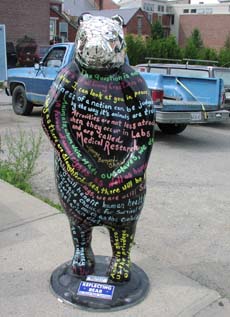index
Will it all be the same ?
click on images for full-size:



Round and round, York, England

Reflecting commentary Bear, Belfast, Maine
In a deeply multi-cultural world themed places would probably be lived with less self-consciousness by the next generation. That is a problem for any themed place, or for any kind of place that requires prominent contrasts (memorials, civic and sacred sites, and so on). Theming is a matter of grammatical norms and not of individual psychological reactions, but there can be grammatical norms specifying appropriate psychological reactions, and those norms can get worn down. Does this mean, then, that places (and cultures) will melt into some hegemonic yet indifferent mix? It is true that there is developing a new world-wide everydayness, which underlies many local grammars. This involves knowing the use of standard machines, familiarity with some cultural icons, perhaps some basic civil society contract behavior, and the like. It is also true that there are questions about just how abstract such a shared everyday can be. But this does not, on its own, demand the development of a single world-wide culture, and there is less evidence for this than first meets the eye. We have to be careful about these issues. We should distinguish a possible world-wide new culture from the world-wide culture of a privileged class (see Castells 1996-98 and the last chapters of Kolb 1990).
- [Return to "theme questions"]
- [Nearby: Themes and hegemonies -- Theming in multi-cultural places ]